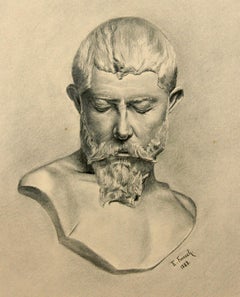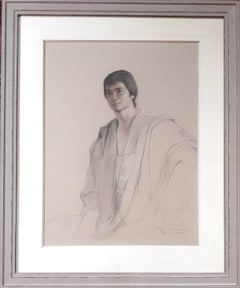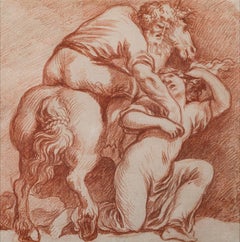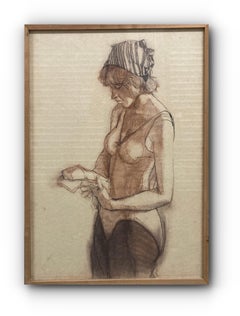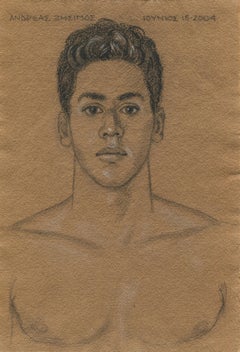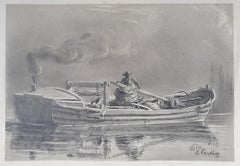Chalk Figurative Drawings and Watercolors
1880s Realist Chalk Figurative Drawings and Watercolors
Chalk
1970s Modern Chalk Figurative Drawings and Watercolors
Conté, Laid Paper, Color Pencil
1760s Old Masters Chalk Figurative Drawings and Watercolors
Chalk
Late 20th Century Chalk Figurative Drawings and Watercolors
Conté, Charcoal
Early 2000s Contemporary Chalk Figurative Drawings and Watercolors
Conté, Graphite
Mid-19th Century Romantic Chalk Figurative Drawings and Watercolors
Paper, Chalk
Late 18th Century Naturalistic Chalk Figurative Drawings and Watercolors
Chalk, Laid Paper, Pencil, Graphite
21st Century and Contemporary Abstract Chalk Figurative Drawings and Watercolors
Chalk, Charcoal
Early 20th Century Impressionist Chalk Figurative Drawings and Watercolors
Chalk, Carbon Pencil
2010s Realist Chalk Figurative Drawings and Watercolors
Conté, Charcoal, Archival Paper
Late 19th Century Chalk Figurative Drawings and Watercolors
Chalk, Charcoal
Late 20th Century Realist Chalk Figurative Drawings and Watercolors
Paper, Conté
Early 20th Century Realist Chalk Figurative Drawings and Watercolors
Chalk
Early 20th Century French School Chalk Figurative Drawings and Watercolors
Chalk, Charcoal, Pastel, Mixed Media
1970s Realist Chalk Figurative Drawings and Watercolors
Paper, Conté
2010s Contemporary Chalk Figurative Drawings and Watercolors
Paper, Chalk
1930s Realist Chalk Figurative Drawings and Watercolors
Conté, Laid Paper
Mid-19th Century Realist Chalk Figurative Drawings and Watercolors
Chalk, Graphite
Mid-19th Century Realist Chalk Figurative Drawings and Watercolors
Chalk, Graphite
Mid-19th Century Realist Chalk Figurative Drawings and Watercolors
Chalk, Graphite
Mid-19th Century Realist Chalk Figurative Drawings and Watercolors
Chalk, Graphite
1860s Realist Chalk Figurative Drawings and Watercolors
Chalk
Early 20th Century Impressionist Chalk Figurative Drawings and Watercolors
Chalk
Early 1900s Art Nouveau Chalk Figurative Drawings and Watercolors
Charcoal, Chalk
Early 18th Century Old Masters Chalk Figurative Drawings and Watercolors
Ink, Chalk
16th Century Chalk Figurative Drawings and Watercolors
Chalk
20th Century Chalk Figurative Drawings and Watercolors
Paper, Chalk
1920s Expressionist Chalk Figurative Drawings and Watercolors
Paper, Chalk, Watercolor
20th Century Romantic Chalk Figurative Drawings and Watercolors
Conté
Late 20th Century Outsider Art Chalk Figurative Drawings and Watercolors
Chalk, Crayon, Pencil, Paper
1920s Art Deco Chalk Figurative Drawings and Watercolors
Charcoal, Chalk, Paper
1750s Old Masters Chalk Figurative Drawings and Watercolors
Chalk, Ink
17th Century Old Masters Chalk Figurative Drawings and Watercolors
Chalk
1950s Modern Chalk Figurative Drawings and Watercolors
Conté
19th Century Chalk Figurative Drawings and Watercolors
Paper, Chalk, Charcoal
Late 20th Century Outsider Art Chalk Figurative Drawings and Watercolors
Chalk, Crayon, Watercolor, Pencil
1970s Other Art Style Chalk Figurative Drawings and Watercolors
Conté, Charcoal, Spray Paint, Board
1910s Academic Chalk Figurative Drawings and Watercolors
Paper, Chalk, Charcoal
2010s Realist Chalk Figurative Drawings and Watercolors
Paper, Conté, Charcoal
18th Century French School Chalk Figurative Drawings and Watercolors
Chalk
2010s Modern Chalk Figurative Drawings and Watercolors
Paper, Chalk
18th Century English School Chalk Figurative Drawings and Watercolors
Paper, Chalk
1960s American Modern Chalk Figurative Drawings and Watercolors
Paper, Conté
1870s Aesthetic Movement Chalk Figurative Drawings and Watercolors
Chalk
1710s Old Masters Chalk Figurative Drawings and Watercolors
Chalk
17th Century Baroque Chalk Figurative Drawings and Watercolors
Paper, Chalk
16th Century Old Masters Chalk Figurative Drawings and Watercolors
Chalk, Ink, Pen, Paper
2010s Contemporary Chalk Figurative Drawings and Watercolors
Paper, Chalk
Mid-18th Century Old Masters Chalk Figurative Drawings and Watercolors
Chalk
2010s Contemporary Chalk Figurative Drawings and Watercolors
Paper, Chalk, Charcoal
Early 19th Century Old Masters Chalk Figurative Drawings and Watercolors
Chalk, Crayon
Mid-19th Century English School Chalk Figurative Drawings and Watercolors
Chalk, Handmade Paper, Pencil
1990s Modern Chalk Figurative Drawings and Watercolors
Conté, Charcoal
1920s Ashcan School Chalk Figurative Drawings and Watercolors
Conté
2010s Modern Chalk Figurative Drawings and Watercolors
Paper, Chalk
Early 2000s Realist Chalk Figurative Drawings and Watercolors
Pastel, Cardboard, Chalk, Pencil
1930s Art Deco Chalk Figurative Drawings and Watercolors
Chalk, Charcoal
1960s Realist Chalk Figurative Drawings and Watercolors
Paper, Conté, Charcoal
1880s Chalk Figurative Drawings and Watercolors
Paper, Chalk, Pencil
1930s American Impressionist Chalk Figurative Drawings and Watercolors
Conté, Postcard, Illustration Board
